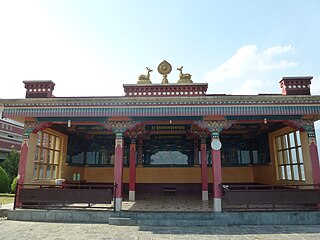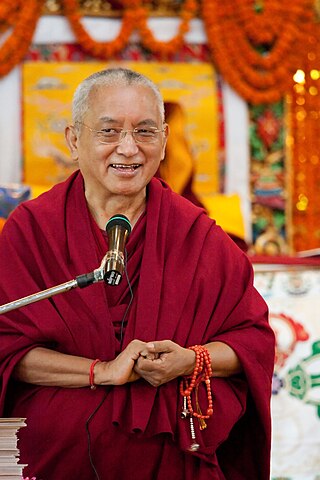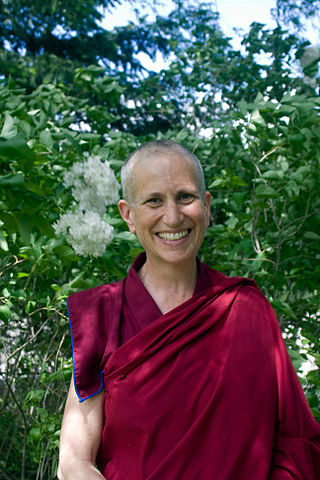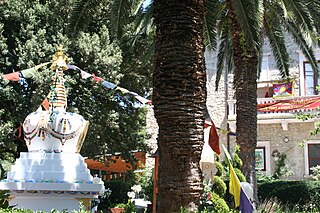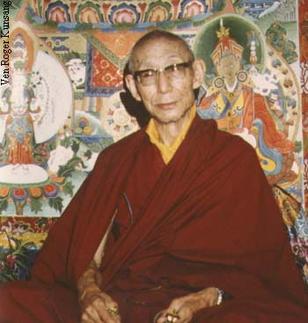History
The name and structure of the FPMT date to 1975, in the wake of an international teaching tour by Lamas Yeshe and Zopa. However, the two had been teaching Western travelers since at least 1965, when they met Zina Rachevsky, their student and patron, in Darjeeling. In 1969, the three of them founded the Nepal Mahayana Gompa Centre (now Kopan Monastery). Rachevsky died shortly afterwards during a Buddhist retreat.
Lama Yeshe resisted Rachevsky's appeals to teach a "meditation course", on the grounds that in the Sera Monastery tradition in which he was educated, "meditation" would be attempted only after intensive, multi-year study of the Five Topics. However, he gave Lama Zopa permission to lead what became the first of Kopan's meditation courses (then semiannual, now annual) in 1971. [3] Lama Zopa led these courses at least through 1975, and sporadically thereafter.
During the early 1970s, hundreds of Westerners attended teachings at Kopan. Historical descriptions and recollections routinely characterize early Western participants as backpackers on the hippie trail (extended overland tours of Asia), to whom Lama Yeshe's style of discourse especially appealed.
Geoffrey Samuel finds it significant that Lamas Yeshe and Zopa had not yet attracted followings among the Tibetan or Himalayan peoples (Zopa's status as a minor tulku notwithstanding), and that their activities took place independently of any support or direction from the Central Tibetan Administration in Dharamsala. On his reading, their willingness to reach out to Westerners was in large measure the result of a lack of other sources of support. Nevertheless, Samuel sees their cultivation of an international network as having ample precedent in Tibet. [4]
In December 1973, Lama Yeshe ordained fourteen Western monks and nuns under the name of the International Mahayana Institute. Around this time, Lama Yeshe's students began returning to their own countries. The result was the founding of an ever-increasing number of dharma centers in those countries. In his description of the FPMT, Jeffrey Paine emphasizes the charisma, intuition, drive, and organizational ability of Lama Yeshe. Paine asks us to consider how a refugee with neither financial resources nor language skills could manage to create an international network with more than a hundred centers and study groups. [5] David N. Kay makes the following observation:
Lama Yeshe's project of defining and implementing an efficient organizational and administrative structure within the FPMT created the potential for friction at a local level. The organization's affiliated centers had initially been largely autonomous and self-regulating, but towards the late-1970s were increasingly subject to central management and control. [6]
As a result, says Kay (and Samuel's analysis concurs), at the same time that the FPMT was consolidating its structure and practices, several local groups and teachers defected, founding independent networks. Geshe Loden of Australia's Chenrezig Institute left the FPMT in 1979, in order to focus on his own network of centers. More consequentially, Kelsang Gyatso and his students caused the Manjushri Institute, the FPMT's flagship center in England, to sever its FPMT ties. At issue was whether the centers and their students ought to identify primarily with Lama Yeshe, local teachers, the Gelugpa tradition, or Tibetan Buddhism as a whole. The FPMT now asks its lamas to sign a "Geshe Agreement" which makes explicit the organization's expectations. [7] The latter rift widened in the wake of unrelated, post-1996 controversy over Dorje Shugden. Following the policy of the 14th Dalai Lama, the FPMT bans the worship of this deity from its centers. [8] [9]
Lama Yeshe's death in 1984 led to his succession as spiritual director by Lama Zopa. In 1986, a Spanish boy named Tenzin Ösel Hita (a.k.a. Tenzin Ösel Rinpoche, or "Lama Ösel") was identified as the tulku of Lama Yeshe. As he came of age, Hita gave up his robes for a secular life, attending university in Spain, and became relatively inactive in the FPMT. In 2009, Hita was quoted in several media sources as renouncing his role as a tulku—remarks which he later disavowed. [10]
On 3 May 2019, Sera lama and FPMT teacher Dagri Rinpoche was arrested for groping a woman aboard an domestic Indian flight. [11] A few days later, a group of nuns drew attention to additional complaints of groping, sexual harassment, and sexual assault by Dagri Rinpoche over a ten-year period, and called for the FPMT to arrange an independent, third-party investigation. A petition to this effect attracted more than 4000 signatures. The FPMT International Office responded by suspending Dagri Rinpoche from its list of teachers, and commissioning FaithTrust Institute to conduct the requested investigation. Its 19 Sept. 2020 report found the allegations credible. Five (out of eight) FPMT board members resigned amidst controversy over whether to release the report. A “draft” summary report was eventually published—so labeled by the FPMT in anticipation of revisions, but the FaithTrust Institute considered its work complete. Besides abuse, the summary also noted a pattern of "coercive or retaliatory behaviors" aimed at silencing complainants; criticized the FPMT for its lack of any clear mechanism to handle such complaints (pp. 38-39); and criticized statements by Lama Zopa which tended to "undermine" the investigation (pp. 11-13). (Zopa had characterized Dagri Rinpoche as “a very positive, holy being—definitely not an ordinary person," and advised Dagri's students to see only his pure qualities.) [12] The FPMT objected that the FPMT centers where the abuse took place were legally independent; and that the report's criticism of Lama Zopa failed to take into account the core principle of guru devotion. [13] FPMT center leaders and registered teachers (but not Tibetan teachers) are now required to take a "Protection from Abuse" online training course. [14] [15] [16]
On the 2023 death of Lama Zopa, the FPMT board indicated that he would have no direct successor, and that the board would collectively assume his responsibilities, subject to the advice of the Dalai Lama. An "advisory council of teachers" is planned. [17]
Bei, Voulgarakis, and Nault use the FPMT to illustrate Arjun Appadurai's understanding of globalization in terms of (in Appadurai's words) "(a) ethnoscapes, (b) mediascapes, (c) technoscapes, (d) finanscapes, and (e) ideoscapes." The authors accordingly describe the FPMT as "an international network of Gelugpa dharma centers headquartered in Portland, Oregon, but founded by Tibetan and Sherpa monks in India and Nepal (one of whom has apparently reincarnated as a Spaniard), and whose funding comes disproportionately from ethnic Chinese communities in East / Southeast Asia." [18]
Structure
The FPMT is headed by a board of directors, with its spiritual director (presently vacant) an ex officio member. The FPMT International Office represents the board's executive function. The president / CEO of the FPMT is currently (2023) Ven. Roger Kunsang, in that office since 2005. [19]
As of 2023, there are 138 FPMT dharma centres, projects, services and study groups in 34 countries. Each affiliated center, project or service is separately incorporated and locally financed. There is no such thing as FPMT "membership" for individuals; rather, membership is held only by organizations (although several of these offer their own, local membership to individuals). In addition to its local board and officers, each FPMT center also has a spiritual program coordinator and in many cases, a resident geshe or teacher (and perhaps other Sangha as well).
The center directors and spiritual program coordinators from various countries meet every few years as the Council for the Preservation for the Mahayana Tradition (CPMT), in order to share experience and deliberate points of mutual concern.
The 14th Dalai Lama is credited with the honorary role of "inspiration and guide". [20]
Publications
Wisdom Publications, now a well-known publisher of Buddhist books, originated at Kopan Monastery, Kathmandu, Nepal, in 1975 under editor Nicholas Ribush. Its first publication was Lama Yeshe's and Lama Zopa's Wisdom Energy. [31] Under Ribush, the publisher began formal operations in London in 1983 (after several years operating out of the Manjushri Institute), with Jeffrey Hopkins' Meditation on Emptiness (1983) as an early perennial. It moved to Boston in 1989, under director Timothy McNeill. The press offers both academic and popular Buddhist literature from all traditions of Buddhism, as well as translations of classic Buddhist literature. Especially noteworthy are its encyclopedia-style project, the 32-volume Library of Tibetan Classics (developed by Thupten Jinpa, English-language translator for the Dalai Lama); and the Teachings of the Buddha series of translations of the Pali Nikāyas.
Diamant Verlag (from 1984) and éditions Mahayana (from 2020) publish Buddhist books in German and French, respectively.
In 1983, the FPMT began publishing a glossy annual called Wisdom. In 1987 it was renamed Mandala and made biannual (and supplemented with newsletters). Between 1996 and 2008 it appeared bimonthly, then quarterly until it ceased publication in 2021.
The Lama Yeshe Wisdom Archive, which holds copyright to the speeches and writings of Lama Yeshe and Lama Zopa, is one of the FPMT's member organizations. The LYWA archives and transcribes teachings by these and other lamas, and produces edited books for free distribution and for sale. Its director is Nicholas Ribush.





